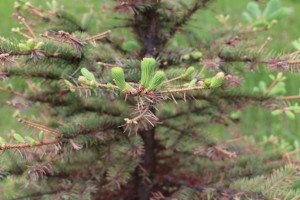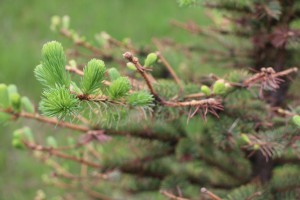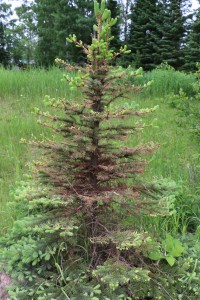Earlier this spring a drive on the Gunflint Trail would have caused alarm in some tree huggers. A bunch of the younger pine trees past the turn off for Gunflint Lake looked like they had been burned in a forest fire. Anyone who knows anything about trees that have been scorched from fire knows that if they have all orange needles then those trees are dead for good. Thankfully that’s not the case for pine trees that have experienced “winter burn.”
These trees can survive a “winter burn” and can experience new growth. Some of the trees at Voyageur Canoe Outfitters had winter burn and now they are getting green buds. That’s a good thing because I sure would hate to lose any trees. Haven’t heard of winter burn? Here’s the scoop from our local expert Master Gardener Diane Booth.
what is winter burn? Winter burn is the result of water loss in plants during the winter. The amount of the water loss is greater than what the plant can replace; thus the needles dry, die and develop a reddish brown color. This is when people start to notice something is wrong with their tree and the office calls begin.
Winter burn occurs on both broad and narrow leaved evergreens. Most of the broad leaved evergreens grown in zone 4 are usually rhododendrons or boxwood. This year my boxwood (Buxus ‘Saskatoon’) was entirely covered with snow so no winter burn was noticed. Typically this winter injury occurs on branches and needles that are above the snow line. When the
snow melts, you discover the top half of an evergreen is a reddish brown while the bottom half that was under the snow is still green.
In winter, even if air temperatures are low, snow cover reflects sunlight, concentrating solar energy on the south
and west sides (especially) of the plant. This raises the internal needle temperatures above air temperature and can
ramp up the photosynthetic process. Several things can happen inside the needles. Transpiration or water loss
increases through the needle stomas as additional water is needed during photosynthesis. If the ground is frozen, the
plant is unable to replace the lost water and dehydrates. If the chlorophyll molecules absorb too much solar energy
and it can’t all be used in the photosynthetic process, chlorophyll (what makes the needle green) can be destroyed through photooxidation and not resynthesized when temperatures are very cold. This can result in bleaching of the foliage. The discoloration of the evergreen branches and needles is what we typically call ‘winter burn’.
If the plant damage is severe enough, plant death can result. If you are concerned, you can check the plant buds and twigs showing signs of winter burn to determine the extent of the damage. If buds and twigs remain green, then new growth will occur in the spring and in a couple of year, the damage will be minimized. Other factors can predispose the trees to winter
burn or injury. A rapid increase or decrease in temperature in the fall before plants have hardened off completely can result in injury or death to plant tissue that is not acclimated. Plants that go into winter stressed are much more likely to be damaged.




Leave a Reply
You must be logged in to post a comment.